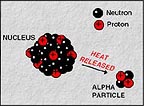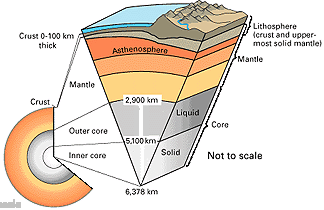
The Earth's internal heat source provides the energy for our dynamic planet, supplying it with the driving force for plate-tectonic motion, and for on-going catastrophic events such as earthquakes and volcanic eruptions. This internal heat energy was much greater in the early stages of the Earth than it is today, having accumulated rapidly by heat conversion associated with three separate processes, all of which were most intense during the first few hundred thousand years of the Earth's history: (1) extraterrestrial impacts, (2) gravitational contraction of the Earth's interior, and (3) the radioactive decay of unstable isotopes.
 Most
scientists believe that our solar system evolved from the accretion
of solid particles derived from a large nebular cloud - the so-called
Nebular Hypothesis. Under this scenario, proto-planet Earth would
have grown over time from a barrage of extraterrestrial impacts,
increasing its mass with each bombardment. As the proto-planet
grew in size its increased gravitational field would have attracted
even more objects its surface. The composition of these colliding
bodies would have included metal-rich fragments (i.e.., iron
meteorites), rocky fragments (i.e., stony meteorites),
and icy fragments (i.e., comets). Although accretion was
much more prevalent in the early stages of the Earth's history,
these extraterrestrial collisions are still occurring today, exemplified
by shooting stars and fireballs in the night sky, and by the occasional
impact of larger bodies on the Earth's surface.
Most
scientists believe that our solar system evolved from the accretion
of solid particles derived from a large nebular cloud - the so-called
Nebular Hypothesis. Under this scenario, proto-planet Earth would
have grown over time from a barrage of extraterrestrial impacts,
increasing its mass with each bombardment. As the proto-planet
grew in size its increased gravitational field would have attracted
even more objects its surface. The composition of these colliding
bodies would have included metal-rich fragments (i.e.., iron
meteorites), rocky fragments (i.e., stony meteorites),
and icy fragments (i.e., comets). Although accretion was
much more prevalent in the early stages of the Earth's history,
these extraterrestrial collisions are still occurring today, exemplified
by shooting stars and fireballs in the night sky, and by the occasional
impact of larger bodies on the Earth's surface.
Such particles travel at great velocities, typically ~30,000--50,000 km/hr, similar to that of the Earth as it rotates around the Sun. The very large amount of kinetic energy inherent in these moving bodies is instantly converted to heat energy upon impact, thus providing a component to the Earth's internal heat source.
In the early stages of planetary accretion, the earth was much less compact than it is today. The accretionary process led to an increasingly greater gravitational attraction, forcing the Earth to contract into a smaller volume. Increased compaction resulted in the conversion of gravitational energy into heat energy, much like a bicycle pump heats up due to the compression of air inside it. Heat conducts very slowly through rock, so that the rapid build up of this heat source within the Earth was not accommodated by an equally rapid loss of heat through the surface.
 Radioactive
elements are inherently unstable, breaking down over time to more
stable forms. The unstable isotope Uranium-238, for example, will
slowly decay to Lead-206. All such radioactive decay processes
release heat as a by product of the on-going reaction. In its
early stages of formation, the young earth had a greater complement
of radioactive elements, but many of these (e.g., aluminum-26)
are short-lived and have decayed to near extinction. Others with
a more lengthy rate of decay and are still undergoing this radioactive
process, thus still releasing heat energy. The greater complement
of unstable elements in the early Earth thus generated a greater
amount of heat energy in its initial stages of formation.
Radioactive
elements are inherently unstable, breaking down over time to more
stable forms. The unstable isotope Uranium-238, for example, will
slowly decay to Lead-206. All such radioactive decay processes
release heat as a by product of the on-going reaction. In its
early stages of formation, the young earth had a greater complement
of radioactive elements, but many of these (e.g., aluminum-26)
are short-lived and have decayed to near extinction. Others with
a more lengthy rate of decay and are still undergoing this radioactive
process, thus still releasing heat energy. The greater complement
of unstable elements in the early Earth thus generated a greater
amount of heat energy in its initial stages of formation.
The heat buildup inside earth reached a maxim early in the Earth's history and has declined significantly since. The greater heat content of the early Earth was the product of (1) a greater abundance of radioactive elements, (2) a greater number of impacts, and (3) the early gravitational crowding. The initial accretion of particles resulted in a rather homogeneous sphere composed of a loose amalgam of metallic fragments (iron meteorites), rocky fragments (stony meteorites), and icy fragments (comets). However, the increased heat content of the early Earth resulted in melting of the Earth's interior, so that the young planet became density stratified with the heavier (metallic) materials sinking to the center of the earth, and the lighter (rocky) materials floating upward toward the surface of the earth. The very lightest volatile materials (derived from comets) were easily melted or vaporized, rising beyond the earth's rocky surface to form the early oceans and the atmosphere. We now have a differentiated earth due to melting and mobilization of materials driven by the earth's internal heat engine. This has resulted in the development of a series of concentric layers that are both density and compositionally stratified. This demonstrated in the diagram below, courtesy of the USGS.

|
These layers include (1) the dense inner core composed largely of solid Fe and subordinate Ni, with radius of about 1200 km, (2) the molten outer core composed largely of liquid Fe, with subordinate sulfur, with a radius of about 2250 km, (3) the mantle, composed of relatively dense rocky materials, with radius of about 2800 km thick, and (4) the crust which comprises the thin relatively light outer skin of the earth, is divisible into two types: the oceanic crust (~7 km thick) and the continental crust (about 35 km thick). Whereas oceanic crust is composed of basaltic rock, the less dense continental crust is composed of a great variety of rock types having an overall average composition akin to granite. |
Within the mantle exists the asthenosphere (Grk. asthenos = weak), between about 100 km and 350 km, which is a special zone composed of hot, weak material that is capable of gradual flow. The layer above the asthenosphere is the lithosphere (Grk. lithos = rock), the rigid and relatively cool outer layer of the earth, composed of both crust and a portion of the upper mantle.
Lying above the lithosphere is (1) the liquid hydrosphere, comprising 71% of the Earth's surface, and (2) that the still lighter gaseous atmosphere, both of which were ultimately derived from the accretion of comets. The occurrence of these volatile components along the outermost portion of the Earth is a product of volcanic outgassing during the differentiation event.